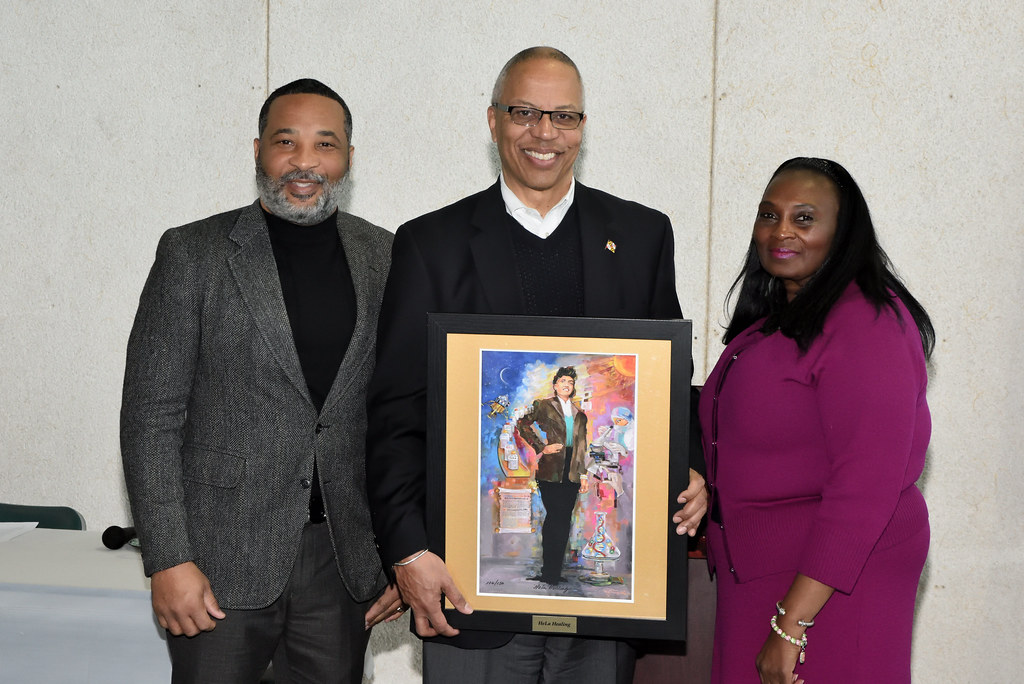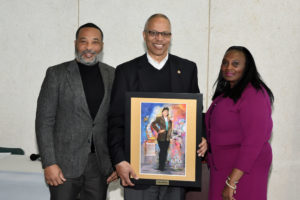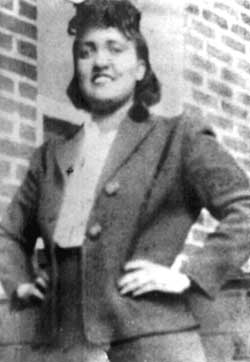Henrietta Lacks was born on August 1, 1920, to a family of tobacco farmers in Roanoke, Virginia. As a girl, she loved swimming in the local creeks and playing with her nine siblings after long hours working on the farm. As a young woman, she painted the town with her girlfriends, dressing up in kitten heels, a smart skirt, with her lips and nails painted red and hair curled on top of her head (Skloot 43). In 1941, Henrietta married her love and began her family, eventually giving birth to five children. Shortly after her 31st birthday, Henrietta died of cancer.
A year before her death, Henrietta noticed that something was wrong. Her abdomen was tender to the touch and sex with her husband had become extremely painful. One day, she gathered the courage to examine the source of pain within her body, and found a tender, rubbery lesion sitting on the entrance to her womb. Later, Henrietta described this mass as a “knot” (Skloot 14). Henrietta knew that her husband had not always been faithful to her, and she assumed this lesion was a consequence of his escapades. Little did Henrietta know that a viciously aggressive form of cervical cancer was currently colonizing her body.
A few months later, Henrietta finally brought herself to Johns Hopkins for treatment, the only hospital in the area which accepted Black patients (Skloot 15). This decision undoubtedly required courage – the local lore within the Black community at the time described Johns Hopkins as a hellish place where Black bodies were experimented upon by white doctors. Nevertheless, Henrietta could not imagine leaving her five children and husband behind, and she steeled herself to receive treatment, no matter the risk.
During her initial consultation at Johns Hopkins, Henrietta’s doctor, Howard Jones, performed a pelvic exam, using his hands to palpate Henrietta’s birth canal, uterus, and ovaries to check for any masses. Then, Dr. Jones inserted a speculum into Henrietta’s vagina so that he could more clearly visualize her cervix, or the tissue that separates the body of the uterus from the vagina. Immediately, Dr. Jones saw something concerning: sitting on Henrietta’s cervix was a hard, purple mass about the size of a quarter. With a scalpel, Dr. Jones excised a sample of this tissue for biopsy and returned with devastating news – it was malignant cancer (Skloot 17).
With the diagnosis still hanging in the air, Dr. Jones began to devise an aggressive treatment plan to target the cervical cancer. In the following months, Henrietta endured rounds of painful radiation and invasive physical exams – all in the hope to slow the cancer. Nothing succeeded. After months of suffering, Henrietta died of metastatic cervical cancer on October 4, 1951, barely ten months after the cancer’s discovery.
To the Lacks family, Henrietta’s illness and death marked the loss of a beloved daughter, sister, wife, and mother. To the field of medical research, however, Henrietta’s illness and death marked the discovery of a biological goldmine.
At one time during her cancer treatment, two additional samples of Henrietta’s cervix were taken. Without her knowledge, these samples were given to Dr. George Gey, a cancer researcher at Johns Hopkins (Skloot 33). After putting Henrietta’s cells under the microscope, Dr. Gey’s team made a discovery that changed medical research forever. Unlike any cells studied before, Henrietta’s cancerous cells could survive in culture (outside of the body) and reproduce new cells at an incredible rate (Skloot 41). Previously, biomedical research had been limited by the short lifespan of cells in culture. Armed with Henrietta’s cells, now christened “HeLa” cells, medical experiments on cells in culture became longer, more elaborate, and more ambitious.
If you have ever received modern medical care – from routine vaccines to cancer treatment – Henrietta and her contribution to medical science have undoubtedly touched your life. Research conducted on HeLa cells led to some of medicine’s greatest achievements, including the polio vaccine, cancer treatments, research on HIV/AIDS, and gene mapping (Skloot 2). Undoubtedly, the discovery of Henrietta’s cells has made life healthier and longer for billions of people since 1951.
Over four decades after Henrietta’s death, journalist Rebecca Skloot contacted the Lacks family while researching for her book The Immortal Life of Henrietta Lacks. She learned that, since the 1950s, each of Henrietta’s family members had “unsatisfactory and untrustworthy experiences with the health care system, and several had no health insurance” (3). The Lacks family was also “furious” to learn that Henrietta’s cells had been used for medical research, with some companies receiving significant “financial gain” from the discovery (3). Even though Henrietta’s cells have bettered human health as a whole, in a cruel twist, Henrietta’s family had never known this benefit for themselves.
As a premedical student with an interest in bioethics, I was surprised it took so long before I learned about Henrietta Lacks. Through writing about Henrietta in the past, I have also learned that this unfamiliarity is not unique to me. Given her incredible contribution to modern medicine, why do so few people know Henrietta Lacks?
A few reasons come to mind: one, Henrietta’s life was brief, two, Henrietta lived and died in poverty, and three, Henrietta was a Black woman living in the Jim Crow South. Perhaps her relative non-famousness indicates a continual effort to write the tragedies and adversity faced by Black individuals out of American history. Although not many know her by name, Henrietta’s legacy is still very much alive, both in medical advancement and in the medical distrust experienced by some communities of color. Stories like Henrietta’s have fueled intergenerational skepticism in medicine and medical research – for good reason: Henrietta never consented to submitting her cervical cells to medical research. In the end, Henrietta died in unbearable pain while medical research boomed, profiting off her lethal cancer tissue.
 Although Henrietta’s story may be unique, plenty of other historical examples of unethical and exploitative medical research exist. Perhaps the most infamous example of medical research in American history is the Tuskegee Syphilis Study. This study, also called “The Tuskegee Study of Untreated Syphilis in the Negro Male,” enrolled hundreds of Black men who were known by researchers to be infected with syphilis. Over the course of 40 years, researchers watched and recorded data as these men’s bodies were slowly ravaged by the disease. The point of the experiment was to observe syphilis’ long-term effects on the body, so no intervention was ever made to cure the participants of the disease. Nearly one hundred men died.
Although Henrietta’s story may be unique, plenty of other historical examples of unethical and exploitative medical research exist. Perhaps the most infamous example of medical research in American history is the Tuskegee Syphilis Study. This study, also called “The Tuskegee Study of Untreated Syphilis in the Negro Male,” enrolled hundreds of Black men who were known by researchers to be infected with syphilis. Over the course of 40 years, researchers watched and recorded data as these men’s bodies were slowly ravaged by the disease. The point of the experiment was to observe syphilis’ long-term effects on the body, so no intervention was ever made to cure the participants of the disease. Nearly one hundred men died.
The legacy of Tuskegee survives, especially in the some communities’ distrust of medical research and public health initiatives. For example, some people mistakenly believe that the Tuskegee study’s men were, in fact, injected with syphilis. Despite contrary evidence, this opinion “continues to be disseminated through media and community resources” (5). As a result, “preventative services that require injection [like vaccines] are especially subject to distrust among [Black Americans].” In the wake of the Covid-19 pandemic and the introduction of a Covid vaccine, this fear has prevented many individuals from getting immunized against the disease. Distrust can be deadly.
For health initiatives to successfully reduce suffering and improve lives, patient-provider and patient-institution trust is vital. As described by “The Role of the Healthcare Provider in Building Trust,” trust often predicts the “willingness of a patient to seek care, share confidential information, comply with treatment regimens, and participate in biomedical research “ (6). In other words, informed and comprehensive medical care cannot exist without trust.
Given the “growing number of large biobank, genomic, environmental and lifestyle precision heath resource research initiatives… the success and impact of this research will largely be determined by how well the participants reflect the age, sex, ethnic, geographic, and socioeconomic diversity of their patient population and the country” (6). In other words, the results of research can only successfully cater to the population’s needs if participants accurately reflect the population’s diversity. So, if Black people are left out of research, it less likely that medical advancements will as profoundly benefit the Black community.
The need to rebuild trust between the Black community and biomedical research has never been more salient than during the Covid-19 pandemic. It is well-documented that the pandemic has disproportionately affected Black people and other people of color, with “Black people experiencing a mortality rate two to three times as high as white or Asian American individuals” (2). Contributing to this high morbidity and mortality is vaccine fear within the Black community, preventing Black people from joining Covid-19 vaccine trials or receiving the immunization at all.
Ironically, “antivaccination interests attempt to build on the history of mistrust in the Black community to discourage research participation and increase vaccine hesitancy” among Black people (2). It is unsurprising that some Black people are skeptical of the Covid vaccine, given a rife history of medical research violating the Black community’s human rights and trust. However, these anti-vaccination interests are not serving the interests of Black people. Every day, members of the Black community continue to die from Covid-19. We know that these deaths are largely preventable with a single dose of a vaccine. It is vital that trust is rebuilt so that people can freely make their own decisions, rooted in information and not fear, about how to care for their bodies.
The Maya Angelou Center for Health Equity (MACHE) is working to rebuild trust between the Black community and health

📸 source: Flickr
institutions in North Carolina. MACHE works in cooperation with the Wake Forest School of Medicine to promote health equity through research, education, and social justice initiatives.
Dr. Allison Caban-Holt, MACHE’s Associate Director, observes that “many of our large medical and academic institutions have faltered in being trustworthy. When we talk about communities, we often say: they don’t trust us. We are putting the onus on the community to trust, when we haven’t yet been trustworthy… We cannot put all of the trust burden on the community. We have to take our place in building the trust and maintaining it.”
Central to MACHE’s mission is developing trusting and mutually-beneficial partnerships with community health leaders. One of MACHE’s recent initiatives, the Triad Pastoral Network (TPN), works to reestablish trust with communities of color through relationships with local faith leaders. Through the TPN, pastors engage with MACHE to promote health in their congregations and develop health ministries.
In “Trust in the Health Care System,” a survey of 683 Black Americans and 998 white Americans, Black Americans reported significantly more trust in informal sources of health information, such as family, friends, and church/religious leaders, “reflecting the importance of informal social networks, faith communities, and extended family.” With this in mind, MACHE has established relationships with these trusted sources – the pastors – to help provide accurate health information to their communities.
The TPN has made huge strides towards improving community health, especially in the wake of Covid-19. In just three weeks, the TPN was able to secure 1,300 responses to a survey exploring attitudes towards Covid-19 and the vaccine. Dr. Caban-Holt reflects on this fantastic response: “why were community members willing to do that for us? Because their pastors were behind the effort working with MACHE, and they knew we were a trusted source.”
In addition to the TPN, MACHE works in three other key ways to rebuild trust and encourage underrepresented populations to participate in research, namely, returning research findings to the community, compensating research participants, and making research more accessible to all.
Dr. Caban-Holt explains, “academic researchers have a bad habit of helicoptering into a community, gathering data, and then helicoptering back out… The community never finds out the results and never hears back from the researchers. At MACHE, once we collect information from a community, we go and give that information back, so the community can see what was found, and we can hear what they think of the results.”
After collecting Covid survey responses, MACHE quickly shared results with TPN pastors, who in turn shared the information with their respective faith communities. In addition, MACHE also synthesized the survey findings into health handouts to educate community members about COVID-19. MACHE completed all of this before drafting formalized reports for their own purposes, in keeping with their promise to always put their communities first.
MACHE also prioritizes participant compensation, which surprisingly, is not the norm within medical research. Compensation serves a dual purpose, both reflecting gratitude and making research participation more accessible to folks who are resource-strained. Dr. Caban-Holt explains, “research can be a luxury that many cannot afford financially or timewise. Through our Integrating Special Populations Program, MACHE makes funds available to researchers to help people who are underrepresented or low-income participate.” These researchers can use MACHE funds to make vouchers for transportation to and from the research site, or to provide child/elder care to the participant’s family while they are away.
Since its inception 20 years ago, MACHE has grown from an office of three to a team of twelve, directed and maintained by women, who are working to improve health outcomes for Winston-Salem’s underserved populations. Dr. Caban-Holt reflects: “we trust that communities know what they need, and we shape our services around the community’s priorities.” In doing so, MACHE lets community stakeholders take the lead in their own health outcomes, then works to support the community’s needs in a way that respects their diversity and autonomy.
For more information on the Maya Angelou Center for Health Equity, please visit:
https://school.wakehealth.edu/Maya-Angelou-Center-for-Health-Equity
Check out MACHE’s Covid Year Book here:
Sources
- Skloot, R. (2010). The Immortal Life of Henrietta Lacks. Crown Publishers.
- Shakkaura, K. (2019). Insight medicine lacks — the continuing relevance of henrietta lacks. The New England Journal of Medicine, 381(9), 800-801. doi:http://dx.doi.org/10.1056/NEJMp1905346.
- Wolinetz CD, Collins FS. Recognition of Research Participants’ Need for Autonomy: Remembering the Legacy of Henrietta Lacks. 2020;324(11):1027–1028. doi:10.1001/jama.2020.15936.
- Hepworth J. Advocacy for Henrietta Lacks and for family medicine. Fam Med. 2011 Sep; 43(8):595-6. PMID: 21918946.
- Kerasidou, A. Trust me, I’m a researcher!: The role of trust in biomedical research. Med Health Care and Philos 20, 43–50 (2017). https://doiorg.ezproxy.princeton.edu/10.1007/s11019-016-9721-6.
- Musa D, Schulz R, Harris R, Silverman M, Thomas SB. Trust in the health care system and the use of preventive health services by older black and white adults. Am J Public Health. 2009 Jul;99(7):1293-9. doi: 10.2105/AJPH.2007.123927. Epub 2008 Oct 15. PMID: 18923129; PMCID: PMC2696665.
- Persaud A, Bonham VL. The Role of the Health Care Provider in Building Trust Between Patients and Precision Medicine Research Programs. Am J Bioeth. 2018 Apr;18(4):26-28. doi: 10.1080/15265161.2018.1431327. PMID: 29621443; PMCID: PMC6604055.



There are no comments
Add yours